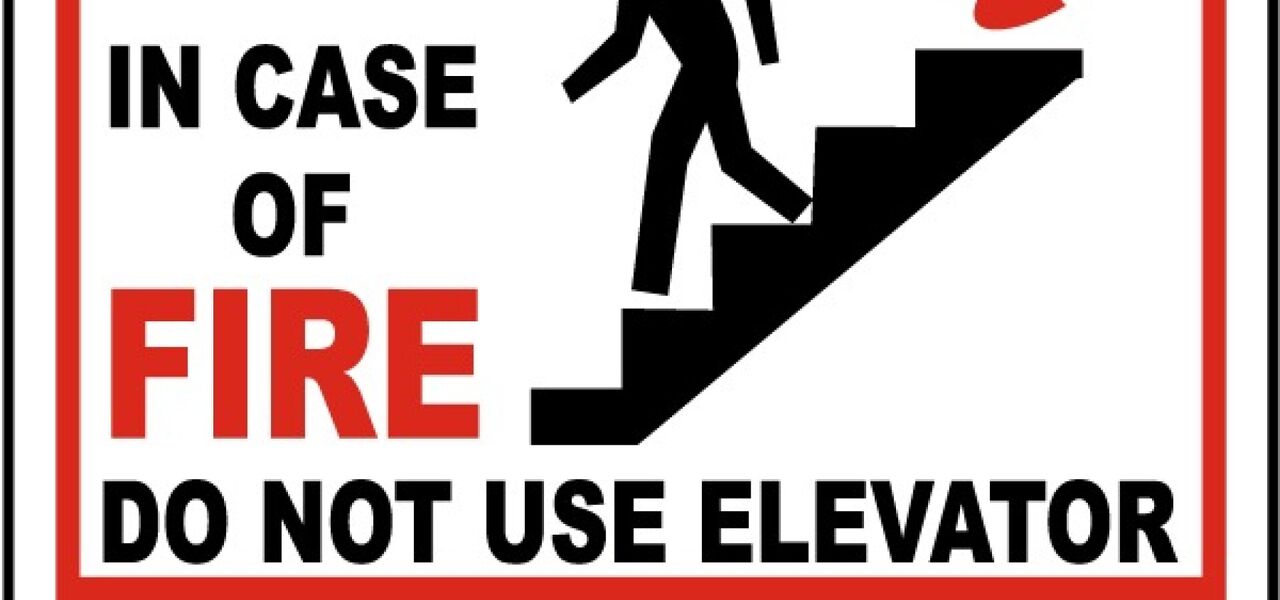
“In case of fire, do not use the elevators.” That is the phrase you can find on any elevator, around the world. It has always been linked in our minds that fire and elevators are not to be mixed. As a professional, this can be attributed to the fact that elevator shafts and cabins would be deemed unsafe during fire conditions, mainly due to smoke collection, possibility of structural failure, and unreliable power supply. These reasons and more can render elevators as more dangerous than saving to human lives.
The human behaviour
However, and mainly starting around the attacks on the Twin Towers of the World Trade Centre on September 11th, 2001, the discussion about using elevators for evacuation has been growing. This in turn has been a major driver for research around the issue. A case study researching human behaviour related to evacuation in high rise buildings was part of the FSEG (Fire Safety Engineering Group of the University of Greenwich, UK) and sponsored by BDAG (Building Disaster Advisor Group of the Office of the Deputy Prime Minister) was conducted. One of the aspects of that study was the usage of elevators in evacuation and how that could have hindered or improved the egress process at the World Trade Centre. The considerable height of the two buildings resulted in an extremely long stairs journey for a lot of people to reach refuge, a journey that can pose a challenge for anyone who’s not athletic enough, young enough, or healthy enough. The large number of occupants on each floor also meant that simultaneous evacuations would most likely cause merging floors and higher crowd densities, hence resulting in obstructions of fatigued people trying to catch their breath on the way. The surveys showed that that in WTC 2 (World Trade Center second building), 95 of the surveyed occupants used the lifts for evacuation, compared to almost none at WTC 1. It was shown that this behaviour has led to decreased congestion, better crowd flow, and eventually higher egress flow rates in WTC 2. The research concluded with a few “what if” scenarios covering the use of elevators in fire related evacuation incidents and the type of procedures that would need to be adopted to make it happen.
But what if the above can be applied to smaller and shorter buildings? Whether that’s hospitals with low mobility patients, elderly homes, or just regular residential and office buildings.
Not fully backed up
As the world is aiming towards a more inclusive environment on various aspects, providing safe evacuation plans for those who cannot “efficiently” use the stairs, regardless of the reason, is essential. As such, Approved Document B (the prescriptive approach standard technical guidance in England) specifically states that the requirement B1 (Means of Warning and Escape) can be met by ensuring the “All people can escape to a place of safety without external assistance”. However, this is not fully backed up with legislative guidance relating to the use of elevators in evacuation.
Typically, in the event of a fire alarm, the elevator would automatically head to the ground level and shut down. This is in accordance with the British Standard EN81-73: 2020; Behaviour of lifts in the event of a fire. Moreover, NFPA 101 Life Safety Code Chapter 7 (Means of Egress, part 14) provides an extensive list of details that would regulate the use of Occupant Evacuation Elevators, including all the technical and management features required. Nevertheless, the actual use of those elevators is still minimal, mainly due to their higher technical requirements and hence increased cost on owners and contractors alike.
Proven to be effective
However, as passenger elevators have proven to be effective in aiding the fire brigades in their extinguishment and rescue service (firefighters’ elevators), why not employ those for personal occupant evacuation. That is before, during, and after the fire brigade arrives on site. Fire fighters’ lifts can help in giving the fire brigade access to all areas of the building as to better tackle the flames. Occupant evacuation elevators can also be used as egress routes in the case of an emergency. Those elevators can be typically used as normal passenger elevators with the capability to be transformed into emergency state if and when required.
The technology to run and operate such elevators exists, but what we are lacking is a specific and straightforward legislation that provides both usage standards, requirements, and detailed certification processes for the technology at hand. Awareness is also a key issue, both for building management companies and the public alike.
Adapting new techniques that have always been deemed as unsafe would be a challenge. Nevertheless, the possibilities that these technologies can provide in protecting human lives, the environment, and properties are endless, so why not utilize them to our own good?
Om journalisten:
Amani er en libanesisk arkitektingeniør med en spesiell interesse for fagfeltet sikkerhet. Hun har også en Mastergrad i brannsikkerhet fra Høgskulen på Vestlandet (HVL), som hun var ferdig med i 2020. Hun har siden begynnelsen av 2021 jobbet som Graduate Fire Engineer ved Arup UK.
Resources:
Principles and Practice of Evacuation Modelling, E.R.Galea (ed.), Fire Safety Engineering Group, University of Greenwich, London Galea, E. R., & Blake, S. (2004). Collection and analysis of human behaviour data appearing in the mass media relating to the evacuation of the World Trade Centre towers of 11 September 2001. London: Office of the Deputy Prime Minister.

